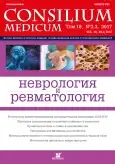Pharmacopuncture application in a complex rehabilitation of patients in the early recovery period of cerebral stroke
- Authors: Drobyshev V.A1, Shpagina L.A1, Gudkova E.V2, Shashukov D.A2, Gribacheva I.A1, Maryanovsky A.A3, Petrova E.V1
-
Affiliations:
- Novosibirsk State Medical University of the Ministry of Health of the Russian Federation
- City Clinical Hospital №2
- N.I.Pirogov Russian National Research Medical University of the Ministry of Health of the Russian Federation
- Issue: Vol 19, No 2-3 (2017)
- Pages: 19-22
- Section: Articles
- URL: https://journals.rcsi.science/2075-1753/article/view/94686
- ID: 94686
Cite item
Full Text
Abstract
Keywords
Full Text
##article.viewOnOriginalSite##About the authors
V. A Drobyshev
Novosibirsk State Medical University of the Ministry of Health of the Russian Federation
Email: doctorvik@yandex.ru
д-р мед. наук, проф. каф. госпитальной терапии и медицинской реабилитации 630091, Russian Federation, Novosibirsk, Krasnyi pr-t, d. 52
L. A Shpagina
Novosibirsk State Medical University of the Ministry of Health of the Russian Federation
Email: lashpagina@gmail.com
д-р мед. наук, проф., зав. каф. госпитальной терапии и медицинской реабилитации 630091, Russian Federation, Novosibirsk, Krasnyi pr-t, d. 52
E. V Gudkova
City Clinical Hospital №2
Email: gudkovaev90@mail.ru
врач-невролог, врач-рефлексотерапевт 630051, Russian Federation, Novosibirsk, ul. Polzunova, d. 21
D. A Shashukov
City Clinical Hospital №2
Email: dm_shash@mail.ru
канд. мед. наук, зав. неврологическим отд-нием 630051, Russian Federation, Novosibirsk, ul. Polzunova, d. 21
I. A Gribacheva
Novosibirsk State Medical University of the Ministry of Health of the Russian Federation
Email: irengri@mail.ru
д-р мед. наук, проф. каф. неврологии 630091, Russian Federation, Novosibirsk, Krasnyi pr-t, d. 52
A. A Maryanovsky
N.I.Pirogov Russian National Research Medical University of the Ministry of Health of the Russian Federation
Email: docaam@yandex.ru
р мед. наук, проф. каф. педитарии №2 117997, Russian Federation, Moscow, ul. Ostrovitianova, d. 1
E. V Petrova
Novosibirsk State Medical University of the Ministry of Health of the Russian Federation
Email: doronin@mail.ru
аспирантка каф. неврологии 630091, Russian Federation, Novosibirsk, Krasnyi pr-t, d. 52
References
- Гусев Е.И., Скворцова В.И. Ишемия мозга. М.: Медицина, 2002.
- Гусев Е.И., Гехт А.Б. Возможности вторичной профилактики инсульта: значение антигипертензивной и антиагрегантной терапии. Журн. неврологии и психиатрии (Прил. Инсульт). 2002; 5: 23-30.
- Батышева Т.Т., Парфенов В.А. Реабилитация больных, перенесших инсульт в поликлинике восстановительного лечения. Лечащий врач. 2003; 3: 76-80
- Белова А.Н., Шепетова О.Н. Нейрореабилитация. Руководство для врачей. М.: Антидор, 2003.
- Керсшот Я. Клиническое руководство по биопунктуре. Использование инъекций биопрепаратов в ежедневной практике. М.: Арнебия, 2013.
- Агасаров Л.Г. Фармакопунктура (фармакопунктурная рефлексотерапия). М.: Арнебия, 2013.
- Якупова А.А. Давлетшина Р.Р., Якупов Р.А. Рефлексотерапия цервикогенной головной боли. Неврологический вестн. 2004; 1-2: 97-8.
- Марьяновский А.А., Рабинович С.А. Общая терапия. Каталог препаратов фирмы «Биологише Хайльмиттель Хеель Гмбх». М.: Арнебия, 2015.
- Дудченко Л.Ш. Гомотоксикология и антигомотоксическая терапия в современной медицине. Таврический медико-биологический вестн. 2005; 8 (2): 100-4.
- Schneider B, Klein P, Weiser M. Treatment of vertigo with a homeopathic complex remedy compared with usual treatments: a metaanalysis of clinical trials. Arznem-Forsch. Drug Res 2005; 55 (1): 23-9.
- Folstein M.F, Folstein S.E, McHugh P.R. Mini-mental state. A practical method for grading the cognitive state of patients for the clinician. J Psychiatric Res 1975; 12 (3): 189-98.
Supplementary files






